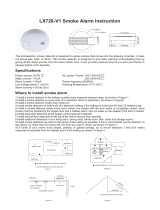
•
DO NOT connect this smoke alarm to any other smoke alarm or
devices except as specifically listed in this manual. Model PG40, GC
and FXW-R smoke alarms can be interconnected with up to 11 other spe-
cific model smoke alarms (Model G-6, as many as 5). DO NOT use exter-
nal bug screens or alarm guards. This may cause improper operation.
•
Smoke alarms must not be used with detector guards unless
the combination of alarm and guard has been evaluated and found
suitable for that purpose.
•
Smoke alarms sound their alarm horns when they detect smoke.
They do not detect heat, flame, or gas. They will not operate if smoke
does not reach the smoke alarm.
•
We recommend that you install a smoke alarm in every room and
on every level of the home. Smoke may not reach the smoke alarm
for many reasons. For example, if a fire starts in a remote part of the
home, on another level, in a chimney, wall, roof, or on the other side of a
closed door, smoke may not reach the smoke alarm in time to alert
household members. A smoke alarm will not promptly detect a fire
EXCEPT in the area or room in which it is installed.
•
Model G-6, PG40, GC and FXW-R smoke alarms meet all NFPA
requirements for new and existing homes. Per the National Fire
Protection Association (NFPA) Standard 72, Chapter 2, this type of
smoke alarm can be used to meet the minimum requirements for new
and existing residential dwellings. The standard requires that smoke
alarms for new residential dwellings be AC powered and interconnect-
ed. Therefore, Model G-6, PG40, and GC can be used to meet the mini-
mum requirements for new construction residential dwellings.
•
Smoke alarms may not alert every household member every
time. There may be limiting circumstances where a household
member may not hear the alarm (e.g., outdoor or indoor noise, sound
sleepers, drug or alcohol usage, the hard of hearing, etc.). If you
suspect that this smoke alarm may not alert a household member,
install and maintain specialty smoke alarms. Current studies have
shown smoke alarms may not awaken all sleeping individuals, and
that it is the responsibility of individuals in the household that are
capable of assisting others to provide assistance to those who may
not be awakened by the alarm sound, or to those who may be
incapable of safely evacuating the area unassisted.
•
This smoke alarm will not provide adequate escape or rescue
time in extremely fast moving fires. Fast fires include gas fires,
flammable liquid fires, or fires set on purpose. The smoke alarm will
not give adequate escape time to people very close to the fire. Such
examples might be, children playing with matches or smokers who
fall asleep and drop a cigarette into their bed.
•
Smoke alarms have limitations. This smoke alarm is not foolproof
and is not warranted to protect lives or property from fire. Smoke
alarms are not a substitute for insurance. Homeowners and renters
should insure their lives and property. In addition, it is possible for
the smoke alarm to fail at any time. For this reason, you must test
the smoke alarm weekly and replace it every 10 years.
SMOKE ALARM PLACEMENT
Invensys Controls Americas recommends complete coverage pro-
tection achieved by installing a smoke alarm in every room of your
home. The National Fire Protection Association’s (NFPA) MINIMUM
requirement for locating smoke alarms in family living units is
detailed in NFPA Standard 72, Chapter 2. It reads as follows:
“2-2.1.1.1 Smoke detectors shall be installed outside of each separate
sleeping area in the immediate vicinity of the bedrooms and on each addi-
tional story of the family living unit including basements and excluding
crawl spaces and unfinished attics. In new construction a smoke detector
also shall be installed in each sleeping room."
Further, section 2-2.2.1 states that:
“In new construction, where more than one smoke detector is required by
2-2.1, they shall be so arranged that operation of any smoke detector shall
cause the alarm in all smoke detectors within the dwelling to sound."
The NFPA, 1993 Edition, Appendix A, however, clearly points out that:
“The required number of smoke detectors [as defined in the paragraphs
above] may not provide reliable early warning protection for those areas
separated by a door from the areas protected by the required smoke
detectors. For this reason, it is recommended that the householder con-
sider the use of additional smoke detectors for those areas for increased
protection. The additional areas include: basement, bedrooms, dining
room, furnace room, utility room, and hallways not protected by the
required smoke detectors.”
Further, the California State Fire Marshal states that the minimum number
of required smoke alarms is not enough to give the earliest warning under
all conditions.The California State Fire Marshal states that:
“Early warning fire detection is best achieved by the installation of fire
detection equipment in all rooms and areas of the household as follows:
A smoke detector installed in each separate sleeping area (in the vicinity,
but outside the bedrooms), and heat or smoke detectors in the living
rooms, dining rooms, bedrooms, kitchens, hallways, attics, furnace rooms,
closets, utility and storage rooms, basements and attached garages.”
It is clear from the above abstracts that the earliest warning of
a developing fire is best achieved by the installation of smoke
alarms in all rooms and areas of the residence. Accordingly,
Invensys Controls Americas recommends that you install smoke
alarms in every room of your residence, even though this is not
required by the typical code or standard.
2
110-427K English 11/8/06 11:03 AM Page 2










